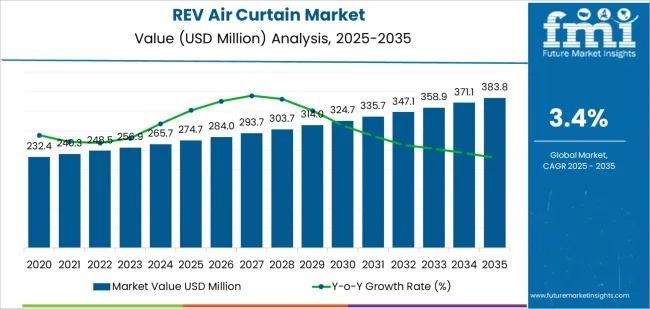REV Air Curtain Market to Surpass USD 383.8 million by 2035

The global REV Air Curtain Market is witnessing steady expansion, projected to grow from USD 274.7 million in 2025 to USD 383.8 million by 2035, representing a CAGR of 3.4%. This growth is fueled by rising demand for energy-efficient entrance solutions across commercial, industrial, and retail facilities. Air curtains serve as controlled airflow barriers that limit outdoor air infiltration, reduce HVAC load, and maintain indoor climate stability while supporting cleaner, healthier indoor environments.
Subscribe for Year-Round Insights → Stay ahead with quarterly and annual data updates: https://www.futuremarketinsights.com/reports/sample/rep-gb-28637
Early in the forecast period, market growth is bolstered by installation activity in retail stores, industrial loading zones, and office buildings seeking temperature control and particulate reduction. Product innovations focus on quieter motors, efficient airflow patterns, and smart controls that adapt output to occupancy and door-open duration. Later in the forecast window, demand remains consistent, driven by replacement cycles and energy-efficiency initiatives during HVAC upgrades or facility retrofits. Enhanced fan performance, flexible mounting options, and automated control features continue to drive adoption, ensuring steady market progress through 2035.
Market Insights: Type, Application, and Regional Trends
Heated air curtains dominate the market with a 42% share in 2025, favored for colder climates and high-traffic entrances that require stable indoor temperatures. These systems reduce HVAC strain and enhance occupant comfort, particularly in retail, office, and public facilities. Manufacturers increasingly incorporate adjustable temperature ranges, multi-speed blowers, and insulated housings to ensure reliable operation under varied conditions.
Commercial buildings lead adoption, representing 58% of the global market in 2025. High-frequency door openings in retail stores, hospitality venues, and offices necessitate air curtains to maintain indoor comfort, reduce energy loss, and limit particulate infiltration. East Asia, Europe, and North America are key regions, where energy codes, building regulations, and commercial growth support wide-scale deployment.
Regional Dynamics and Market Drivers
China leads global growth at a CAGR of 4.6%, driven by strong commercial construction, HVAC modernization, and energy-saving entrance technologies. Retail, healthcare, and logistics facilities increasingly integrate sensors for door status and adaptive airflow modulation, enhancing efficiency and operational reliability. India follows with a 4.3% CAGR, propelled by retail expansion, rising hygiene awareness, and modular, energy-efficient product designs.
Germany (3.9% CAGR) benefits from stringent energy codes, low-noise standards, and integration with building management systems. Brazil (3.6%) sees growth from tropical climate considerations, mall refurbishments, and indoor air quality requirements. The U.S. (3.2%), UK (2.9%), and Japan (2.6%) are mature markets focused on compact, eco-friendly units and automated system integration to meet urban and high-density facility requirements.
Technology, Innovation, and Market Trends
Next-generation air curtains feature quieter motors, improved fan efficiency, electronically commutated drives, and automatic controls that respond to door activity and occupancy. Slimmer housings and customizable lengths enhance architectural compatibility. Industrial applications increasingly rely on high-velocity models for climate-sensitive environments, while hygiene-focused units gain traction in food processing and laboratory settings. Energy efficiency, operational reliability, and reduced noise remain critical differentiation factors for manufacturers.
Competitive Landscape and Strategic Opportunities
The REV air curtain market is moderately fragmented. Berner International leads with energy-efficient systems for high-traffic commercial applications. Boon Edam and Systemair offer integration with revolving doors and automated entrances. Envirotec, Biddle, JS Air Curtains, and Powered Aire provide mid-range solutions for industrial and retail applications, focusing on airflow stability, durability, and low-noise operation. Airtecnics and Frico enhance energy management capabilities with electronically regulated airflow, while Tekadoor, Stavoklima, and NHS Air Curtains address cold-storage and climate-sensitive needs. Strategic differentiation relies on motor efficiency, mounting flexibility, and adherence to energy codes.
- Art
- Causes
- Crafts
- Dance
- Drinks
- Film
- Fitness
- Food
- Spiele
- Gardening
- Health
- Startseite
- Literature
- Musik
- Networking
- Andere
- Party
- Religion
- Shopping
- Sports
- Theater
- Wellness


